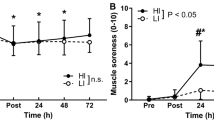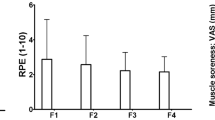Abstract
Purpose
To examine the influence of estradiol on muscle damage and leg strength after intense eccentric exercise.
Methods
Eight men (MEN), eight normally menstruating women (WomenNM), and eight women using oral contraceptives (WomenOC) participated in this study. Subjects performed 240 maximal-effort bilateral eccentric contractions of the quadriceps muscle groups designed to elicit exercise-induced muscle damage (EiMD). Serum creatine kinase (CK), myoglobin (Mb), and fatty acid-binding protein (FABP) concentrations were measured before (pre-) EiMD, as well as 0, 6, 24, and 48 h post-EiMD. Peak isometric quadriceps torque (i.e., leg strength) was measured pre-EiMD, as well as 24 and 48 h post-EiMD.
Results
The increases in CK, Mb, and FABP concentrations from pre- to post-EiMD were greater in MEN (10-fold, 15-fold, and fourfold, respectively) and WomenOC (sevenfold, 11-fold, and ninefold) compared with WomenNM (five-, six-, and threefold; p < 0.05). The decline in leg strength was about 10 % pre- to 24 h post-EiMD in all groups and decreased a further 10–15 % by 48 h post-EiMD in the MEN and WomenOC only.
Conclusion
Our findings suggest an important role of estradiol in blunting the muscle damage response to intense eccentric exercise and preserving muscle function after EiMD.



Similar content being viewed by others
Abbreviations
- EiMD:
-
Exercise-induced muscle damage
- CK:
-
Creatine kinase
- Mb:
-
Myoglobin
- FABP:
-
Fatty acid-binding protein
- WomenNM:
-
Normally menstruating women
- WomenOC:
-
Women taking the oral contraceptive pill
References
Buckley-Bleiler R, Maughan R, Clarkson P, Bleiler T, Whiting P (1989) Serum creatine kinase activity after isometric exercise in premenopausal and postmenopausal women. Exp Aging Res 15:195–198
Carter A, Dobridge J, Hackney A (2001) Influence of estrogen on markers of muscle tissue damage following eccentric exercise. Hum Physiol 27:626–630
Chaffin M, Berg K, Meendering J, Llewellyn T, French J, Davis J (2011) Interleukin-6 and delayed onset muscle soreness do not vary during the menstrual cycle. Res Quart Exerc Sport 82:693–701
Clarkson P, Hubal M (2001) Are women less susceptible to exercise-induced muscle damage? Curr Opin Clin Nutr 4:527–531
Clarkson P, Tremblay I (1988) Exercise-induced muscle damage, repair, and adaptation in humans. J Appl Physiol 65:1–6
Dannecker E, Liu Y, Rector S, Thomas T, Fillingim R, Robinson M (2012) Sex differences in exercise-induced muscle pain and muscle damage. J Pain 13:1242–1249
Dieli-Conwright C, Spektor T, Rice J, Schroeder E (2009) Hormone therapy attenuates exercise-induced skeletal muscle damage in postmenopausal women. J Appl Phsyiol 107:853–858
Enns D, Tiidus P (2010) The influence of estrogen on skeletal muscle: sex matters. Sports Med 40:41–58
Esbjorsson-Liljedahl M, Holm I, Sylven C, Jansson E (1996) Different responses of skeletal muscle following sprint training in men and women. Eur J Appl Physiol 74:375–383
Fredsted A, Clausen T, Overgaard K (2008) Effects of step exercise on muscle damage and muscle Ca2+ content in men and women. J Strength Cond Res 22:1136–1146
Garcia-Segura L, Azcoitia I, DonCarlos L (2001) Neuroprotection by estradiol. Prog Neurobiol 63:29–60
Imai Y, Kondoh S, Kouzmenko A, Kato S (2010) Mini review: osteoprotective action of estrogens is mediated by osteoclastic estrogen receptor-alpha. Mol Endocrinol 24:877–885
Joyce S, Sabapathy S, Bulmer A, Minahan C (2014) The effect of prior eccentric exercise on heavy-intensity cycling: the role of gender and oral contraceptives. Eur J Appl Physiol 114:995–1003
Kendall B, Eston R (2002) The effect of menstrual cycle status and oral contraceptive use on exercise-induced muscle damage. J Sports Sci 20:53–54
Mendelsohn M, Karas R (1999) The protective effects of estrogen on the cardiovascular system. N Engl J Med 340:1801–1811
Miles M, Andring J, Pearson S, Gordon L, Kasper C, Depner C, Kidd J (2008) Diurnal variation, response to eccentric exercise, and association of inflammatory mediators with muscle damage variables. J Appl Physiol 104:451–458
Montgomery P, Pyne D, Cox G, Hopkins W, Minahan C, Hunt P (2008) Muscle damage, inflammation and recovery interventions during a 3-day basketball tournament. Eur J Sport Sci 8:241–250
Pizza F (2009) Comments on point: counterpoint: estrogen and sex do/do not influence post-exercise indexes of muscle damage, inflammation, and repair. J Appl Physiol 106:1016
Roth S, Martel G, Ivey F, Lemmer J, Metter E, Hurley B, Rogers M (2000) High-volume, heavy-resistance strength training and muscle damage in young and older women. J Appl Physiol 88:1112–1118
Roth S, Gajdosik R, Ruby B (2001) Effects of circulating estradiol on exercise-induced creatine kinase activity. JEPonline 4:10–17
Savage K, Clarkson P (2002) Oral contraceptive use and exercise-induced muscle damage and recovery. Contraception 66:67–71
Sayers S, Clarkson P (2001) Force recovery after eccentric exercise. Eur J Appl Physiol 84:122–126
Sewright K, Hubal M, Kearns A, Holbrook M, Clarkson P (2008) Sex differences in response to maximal eccentric exercise. Med Sci Sports Exerc 40:242–251
Sorichter S, Mair J, Koller A, Pelsers M, Puschendorf B, Glatz J (1998) Early assessment of exercise induced skeletal muscle injury using plasma fatty acid binding protein. Br J Sports Med 32:121–124
Sorichter S, Mair J, Koller A, Calzolari C, Huonker M, Pau B, Puschendorf B (2001) Release of muscle proteins after downhill running in male and female subjects. Scand J Med Sci Sports 11:28–32
Stupka N (2009) Comments on point: counterpoint: estrogen and sex do/do not influence post-exercise indexes of muscle damage, inflammation, and repair. J Appl Physiol 106:1017–1018
Stupka N, Lowther S, Chorneyko K, Bourgeois JM, Hogben C, Tarnopolsky MA (2000) Gender differences in muscle inflammation after eccentric exercise. J Appl Physiol 89:2325–2332
Thompson H, Hyatt J, De Souza M, Clarkson P (1997) The effects of oral contraceptives on delayed onset muscle soreness following exercise. Contraception 56:59–65
Tidball J (2005) Inflammatory processes in muscle injury and repair. Am J Physiol Regul Integr Comp Physiol 288:R345–R353
Warren G (2009) Comments on point: counterpoint: estrogen and sex do/do not influence post-exercise indexes of muscle damage, inflammation, and repair. J Appl Physiol 106:1018
Warren G, Lowe D, Amstrong R (1999) Measurement tools used in the study of eccentric contraction-induced injury. Sport Med 27:43–59
Warren G, O’Farrell L, Rogers K, Billings K, Sayers S, Clarkson P (2006) CK-MM auto-antibodies: prevalence, immune complexes, and effect on CK clearance. Muscle Nerve 34:335–346
Author information
Authors and Affiliations
Corresponding author
Additional information
Communicated by William J. Kraemer.
Rights and permissions
About this article
Cite this article
Minahan, C., Joyce, S., Bulmer, A.C. et al. The influence of estradiol on muscle damage and leg strength after intense eccentric exercise. Eur J Appl Physiol 115, 1493–1500 (2015). https://doi.org/10.1007/s00421-015-3133-9
Received:
Accepted:
Published:
Issue Date:
DOI: https://doi.org/10.1007/s00421-015-3133-9




